Evaluating Korean Celadon - Old and Modern
Praised by the 8-12th century Sung
Chinese for its "kingfisher" blue-green color, lost as an art form
after the Koryo Dynasty, and then rediscovered and
collected aggressively by the Japanese, Korean celadon has never lost its
inherent value, beauty, or appeal. While the most valuable celadon is generally the
older, Koryo Dynasty celadon, modern celadon is often better made, and
frequently has a great value all its own.
The golden age of celadon in Korea was during the middle
and latter part of the 11th century when the influence of Buddhism increased the
need for fine vessels to be used during religious ceremonies and more celadon was produced
to meet the need. By 1231 AD the influence of Buddhism and the flourishing
culture began to decline, and along with it, the quality of the pottery being
produced. By the beginning of the Chosun Dynasty (1392-1910) most of the
delicate manufacturing techniques for celadon had been lost. There was a
re-birth of celadon in the 1950s when a group of Korean artisans set out to
discover the lost art of Koryo celadon. Since that time, they have made great
progress in rediscovering the secret techniques and much of the celadon made today is of
better quality than that of the Koryo Dynsasty. Learn more about the
History of
Korean Celadon here.
The value of older celadon (pre-1950) is based primarily on its age,
uniqueness, skill used in making it, and its level of preservation. More modern
celadon - that which was made after the re-birth - it primarily valued by its
beauty, uniqueness, and the fame of the artisan who made it. Preservation is
generally not an issue since most modern celadon is in good condition.
Old celadon:
Appearance
In most cases, old celadon is easy to distinguish from modern celadon even by casual observance. The
majority of Koryo era celadon was recovered from tombs in the early 1900's where
it had been buried for hundred's of years, and so it tends to appear as if...
well, as if it
had been buried in the ground for hundreds of years. That is, the color is often
faded from its original vibrancy, the glaze is often pockmarked from water damage, and it
frequently has some
physical damage to it - either
repaired or not. Additionally, the pieces that have made it down through time to
the present, are not necessarily the best or most beautiful of their era, but are
more of a hodgepodge of pieces, many of which were good enough for burial, but
not much more. Those pieces that were exceptional, have mostly made their way
into museums. Therefore, a good deal of the old celadon today, is less than spectacular and often appears malformed,
damaged, or severely weather-beaten.
Another telling mark of a piece's age, is its base. Kilns used during the
Koryo Dynasty were made of earth and generally had sand or earthen
floors. The pots were placed on the bare floors and so tended to pick up residue
from the floor or have their bases deformed by contact with the floor. In order to keep the piece off the floor
of the kiln, potters would place three small pieces of sand, pebbles, or shells under the piece to
prop it up off the floor. After the firing, the pieces of sand were broken off
but left telltale marks on the bottom of the piece called
"spur marks". Modern
celadon is made in neat, sterile kilns and has no spur marks.
Modern celadon nearly always has the mark of the artisan who created it
written in Chinese characters, but old celadon mostly did not, or if it did, the
mark is so faded as to be unrecognizable. Glazed bottoms, which are common on
all modern celadon, were sometimes not used on older celadon due to the
difficulty in keeping the base debris free.
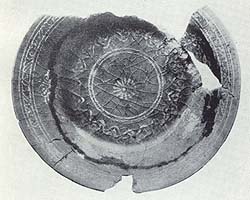 |
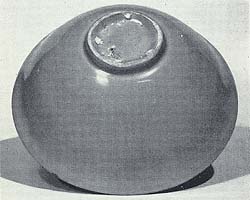 |
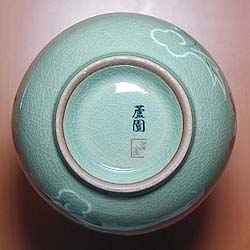 |
Damaged celadon dish with inlaid floral
decoration, even so, it is displayed in the
National Museum of Korea.
|
Plain celadon bowl, with spur marks on
the base.
|
Modern celadon Mae-byeong (vase), with perfect, glazed base, and the artist's mark, written in Chinese characters - the red mark is a personal stamp used by some artisans which is the equivalent of a signature |
Value
The value of old celadon can range from $500 for a poorly
preserved, deformed bowl, with damage, to priceless for a perfect specimen such
as many of those in the National Museum of Korea. For the most part, all old celadon is
quite valuable and even pieces that are incomplete due to damage, generally have
value. Determining the exact value is where things get difficult. As mentioned
above, the general guidelines for determining a piece's value are age,
uniqueness, skill used in making it, and its level of preservation. As with most
antiques, the age of a piece has a great influence, as the older a piece is,
generally the more valuable it is. This is usually true for celadon as well,
however there are some exceptions to consider. Items from the golden age of
celadon tend to be more valuable than those that were produced earlier or later,
because of the excellent craftsmanship employed in works of that
era. However, works from an earlier or later period that belie the craftsmanship
of their era could
be equally, or more valuable. For example, a shard of white porcelain with inlay
from a period in which it was thought that inlay was not used, may be more
valuable than a complete - but more common piece from another time.
The criteria above also ties in with its uniqueness. While bowls,
Mae-byeong or Ju-byeong may be quite common, a more unique piece, or one of a kind
piece, would have a much greater value.
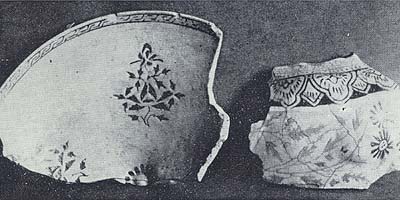 |
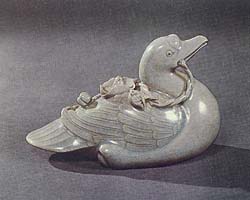 |
White porcelain shards with inlaid decoration, from the 12th or 13th century - inlaid white porcelain is quite rare. |
Unique celadon water dropper in the form of a duck
|
The level of preservation of a piece is likewise important and in general, the less color fading or other damage to the celadon glaze, the more valuable the piece will be. The same holds true for exterior physical damage, like missing handles and such - the more complete, the better. In summation, a common piece of which a great number were made, with some fading of the glaze, and pockmarked from water damage with a few chips out of it, may fetch little more than a few hundred dollars. But a well preserved piece with good color, no damage and of a nice design may be worth $30,000 or more, such as a small celadon cosmetic box (hyang-hap) which was recently evaluated on a Korean antique show.
Back to the top
Modern celadon
Appearance
Modern celadon (that which has been made since the re-birth of celadon in the
1950's) varies in appearance depending on when it was made. The skill of celadon
artisans has increased over the years, so it follows that the earlier works
would generally have a less vibrant or uniform color of glaze, less symmetry in
their shapes, and less detail in the inlaid designs. Pieces made more recently
all have a mostly symmetrical shape, uniform color and and fairly well detailed
inlay. Most modern celadon also has a glazed base, with the name of the artisan
who created the piece written in Chinese characters.
The difference between modern celadon of high quality, and that of lesser
quality can be seen in the detail of the inlay or painting, and the uniformity
and color of the glaze. Upon
close inspection, the inlaid and painted portions of a lower quality piece will
appear somewhat blurred and indistinct, while those of better quality will be
clear in detail and form. The depth and color of the glaze are another
telling feature. The deep jade-green glaze of quality works has a rich color,
and clarity
that far surpasses that of lesser works.
Value
As with old celadon, determining the value is where things get tricky. As
previously mentioned, there are three factors, that contribute to a modern
piece's value:
beauty, uniqueness, and the fame of the artisan who made it. The more beautiful
a piece is, to include the level its craftsmanship, uniform color of glaze, and detail in the designs,
the higher its value will be. A more
detailed work also takes more time to create, and so there are likely fewer
copies of that piece, which further adds to its value. Therefore, uniqueness,
generally accompanies quality. Artisans of some renown, make better quality
pieces, which take more time, and therefore, they create fewer of them, so they
end up being more unique.
We receive numerous letters inquiring about the value of
celadon acquired years ago, either during the war, or the decades following it.
The following guidelines are generally true about pottery acquired since the
war. Celadon pieces
that were acquired during the Korean war or shortly after, are likely to have some
increased value over its intrinsic value, since there was virtually no celadon production during
the war and those pieces that were available, were probably from an earlier age.
Works that were acquired in the 60's through 70's were either from the budding
celadon industry of the time, or were earlier works. That determination can be
made by the way that the piece was acquired. A piece that came from a shop in
Seoul, with dozens of other similar pieces and was purchased for a low price, was
probably produced by one of the pottery shops of the time and may or may not
have increased value. A work that was purchased from a specialty shop, that looked
like an antique at the time of purchase, was unusually expensive or unique
looking, may have been one of the many antiques that were sold during that era
for financial gain. It should be remembered that Korea did not become the
economic powerhouse that it is today, until the mid 80's and in the years after
the war, life was difficult. Many people had to sell priceless family heirlooms
simply to survive. Works purchased in the 80's to present, are most likely from
the modern celadon industry and their value can be determined by the other
factors mentioned above - beauty, uniqueness, and fame of the maker.
It should be noted that the above guidelines are designed to serve only as a guide. Please do not base an evaluation of a piece of celadon on the guidelines above. If you feel a piece is monetarily valuable, it may very well be. Do not dismiss a work based on our very broad guidelines. Ultimately, the monetary value doesn't really matter. As with all art, if the piece is beautiful, and you enjoy it, then it could not possibly have a greater value than that.
Back to the top
Comparisons
In order to help differentiate between old and modern pieces, we have compiled some pictures of comparable celadon pieces from the Koryo Dynasty, and modern pieces below.
Old Celadon |
Modern Celadon |
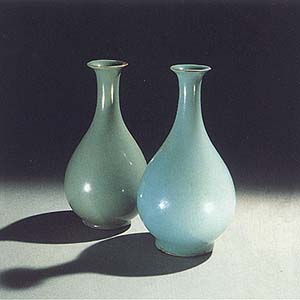 |
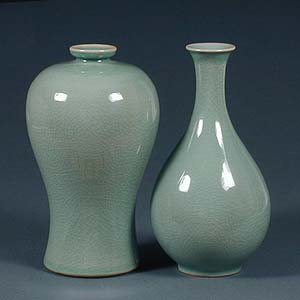 |
The bottle on the left is Korean celadon from the early 12th century, Koryo Dynasty. The bottle on the right is late 11th to early 12th century Chinese celadon. |
Mu-ji (plain) Vase & Bottle |
¡¡
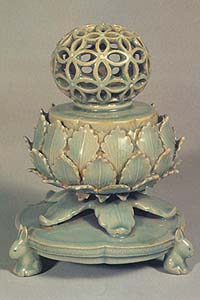 |
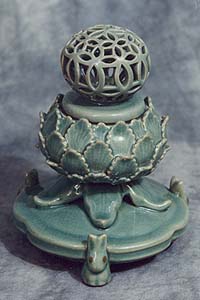 |
Sculptured incense burner, 12th century |
Lotus & Rabbit Incense Burner |
¡¡
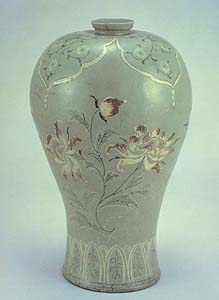 |
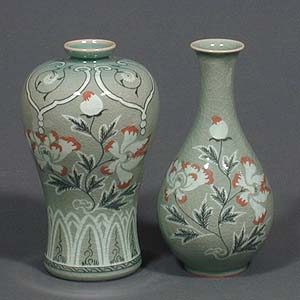 |
Inlaid and underglaze painted Mae-byeong vase, 12th century |
Pink Peony Vase & Bottle |
¡¡
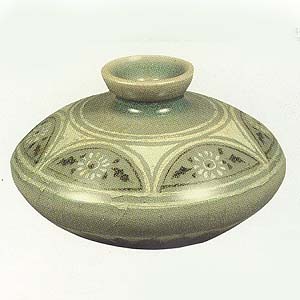 |
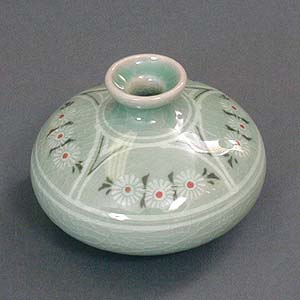 |
Inlaid celadon oil bottle, 13th century |
Chrysanthemum & Lunettes Oil Bottle |
Back to the top
Links
Unfortunately, Korean-Arts does not offer an
appraisal service at this time for Korean celadon. In our opinion, appraisal by
any other means than direct contact with the piece is not appropriate, and their
location in Korea, while fine for viewing local wares, prevents them from
viewing items in the US or Europe.
Below are listed several sites of interest that may be
helpful in the evaluation of a piece of celadon or Korean art. The first is an
auction site that has a section dedicated to Korean art, and may be helpful for
viewing items similar to one you are trying to evaluate, and the second is a
dedicated appraisal site. Korean-Arts has no business relationship with either
of these sites, and cannot vouch for their business practices, or level of
expertise. We are providing these links simply as a source to find more
information about the art of Korea.
Trocadero: Antiques: Regional Art: Asian: Korean: Ceramics
Van Weyenbergh Fine Arts Inc. Art Appraisal
Back to the top